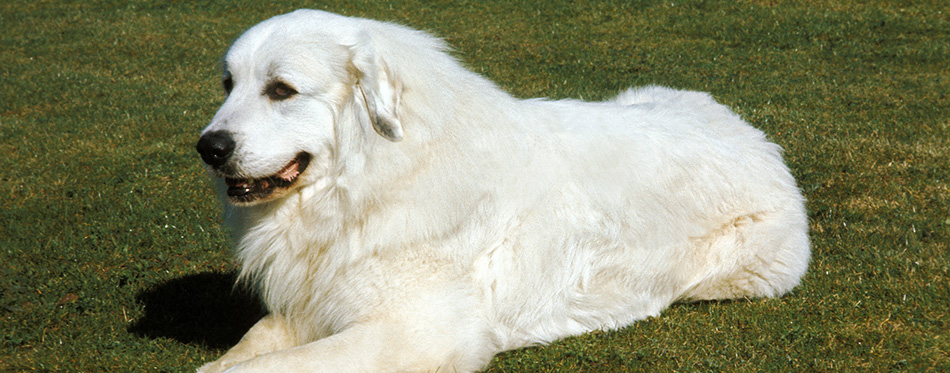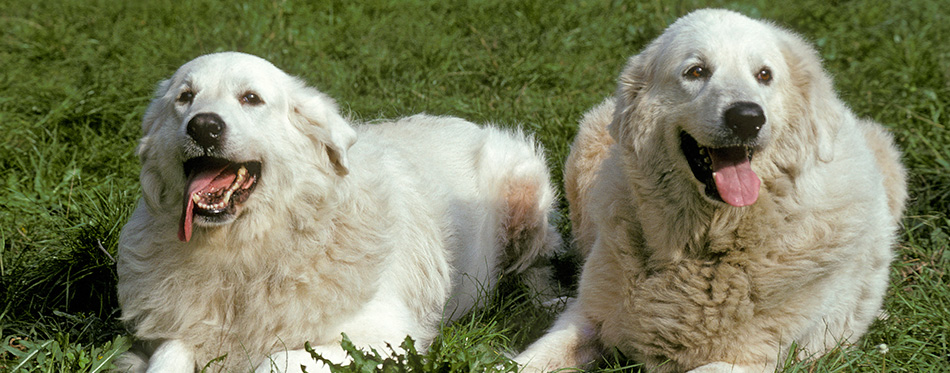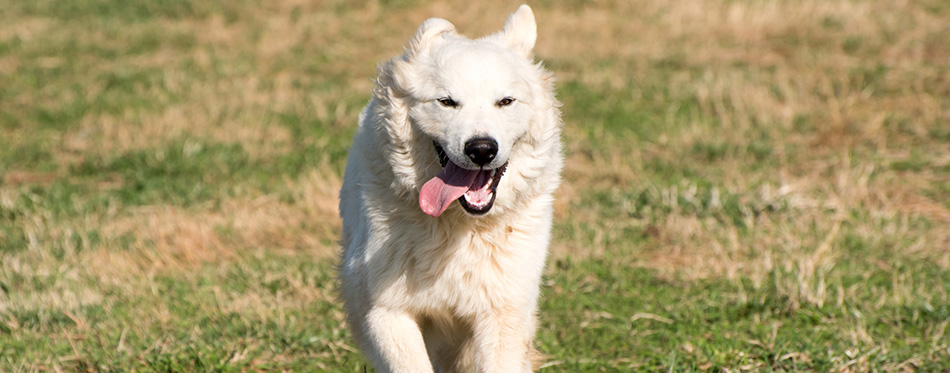The Great Pyrenees dog is a breed that can easily be misjudged due to its size. It is a large dog that measures between 70-82cm in height and generally weighs anywhere between 65 and 82kg. Don’t let this bother you as it is a big softie at heart. Fiercely protective, it is a great dog to have as a pet, and with its beautiful coat of fur, it is also pleasing to the eye.
Historically speaking, the Great Pyrenees dog was used as a livestock guardian dog, which informs its tendency to act protective towards family and smaller animals against larger ones. It is an energetic dog that requires a lot of exercise, but it will be gentle around your kids. If you are looking for a new dog, the Great Pyrenees is an excellent option to go for due to its demeanor and its loyalty to the people that matter.

History
One can look to the 1500s for the first recorded account of the Great Pyrenees dog in a book called Libro de los secretos de la Agricultura, casa de campo y pastoril. The book explained why the breed of dog was a preferred option for shepherds who wanted a dog to watch after the sheep. They derive their name from the Pyrenees– a range of mountains that form a natural border between France and Spain. The region was home to a lot of livestock owners, and an essential part of their culture was the practice called ‘transhumance’ which was the act of moving livestock from the valley areas to higher climes for the summer period.
This movement was not without risk as there were wolves and other large predators that would seek to harm the livestock. This was where the usefulness of the Pyrenee mountain dog came into play. They were incredibly helpful in the protection of sheep and other livestock and could go for days simply watching the sheep and their thick fur also means that they are resistant to cold. What’s more, shepherds typically preferred these dogs because of their color (they were white.) This means that they were usually alerted when the dog sets off after a wolf and could also recognize when the dog was moving around at night. In 1675, it received its highest honor as it was designated the Royal Dog of France by the Dauphin Louis XIV which increased the demand for the dog, and it became incredibly popular if not homogenized.
In 1931, thanks to the efforts of Mary and Francis Crane, the Great Pyrenees came to the United States. The couple bred the dog, importing nearly 60 dogs from France and other parts of Europe, and in 1933, the American Kennel Club formally recognized the Great Pyrenees as a breed of dog. They have since then become a staple of the American home and have appeared in pop culture including in movies such as ‘Dumb and Dumber’ and ‘Finding Neverland’
Quick Facts About the Great Pyrenees Dog
Here are a few things to know about this amazing dog
- They are pretty ancient. While the first accounts of them were recorded in the 1500s, there have been fossils of the dog found in the Pyrenean mountains and other regions. It was discovered that these fossils dated back as far as 1800BC and 1000BC which has led to the theory that the Great Pyrenees dog moved around with shepherds in the Pyrenees mountains way back in 3000BC and that they probably evolved from white mountain dogs that populated the region and originated from Asia Minor.
- They are nocturnal creatures. Most dogs are blessed with impeccable eyesight, but due to their long history guarding livestock both day and night, Great Pyrenees are mainly active at nighttime. This could be a bit of a hassle for pet owners as they are prone to barking at night, which could be a problem if there are neighbors around. On the other hand, it also means that thieves are a lot less likely to try and burgle the house, knowing that there is a barking dog in the compound.
- They are celebrity dogs as they gained wide popularity in France during the Renaissance period, especially with royalty. They have been credited with helping to guard the Chateau fort de Lourdes, a castle from way back in the day. As mentioned earlier, in 1675, it was named as the Royal Dog of France by the Dauphin Louis XIV.
- This popularity wasn’t restricted to France as the Pyrenee mountain dog was also a pet to Queen Victoria of England. An avid dog lover, the queen, was said to have had a lot of dogs all of different breeds during her time on earth. The Great Pyrenees was said to be one of the dogs owned by the queen.
- They are natural guard dogs. Having been deployed as guards for livestock in the Pyrenees mountains, they have a natural inclination to protect. They were bred alongside the Pyrenean Shepherds, and together they kept sheep safe from wolves and bears. While the latter was in charge of herding the animals, the former kept the animals safe and could do this for most of the day even in freezing conditions thanks in large part to their thick coats.
- They make great nurturing pets. This is because of their inherent need to protect and nurture, honed by their history guarding smaller and weaker animals. They are kind and patient with inferior animals and will seek to protect such animals from any sort of harm.
- They were instrumental in the revival of the St Bernard. The St Bernard breed had become so depleted due to avalanches in Switzerland that they needed to be brought back from the brink of extinction. Using the blood of the Great Pyrenees and other large breeds, this noble breed of dog was saved from evisceration.
- While some accounts credit Mary Crane with establishing the Great Pyrenees as a breed in America, it is believed that the Marquis de Lafayette was the first to bring the dog to the United States.

Things You Should Know About The Great Pyrenees
Here are some other essential things to know about this dog breed:
Health
The Great Pyrenees is a dog that can be beset with health issues. Always ensure that you get an honest dog breeder who will furnish you with all the requisite information about the health of the dog you’re getting. Some of the common health issues you might encounter with this dog are:
- Hip Dysplasia; This is a common genetic issue that affects most dogs. Hip dysplasia is a condition that affects the bones of dogs the Great Pyrenees’ size or larger and makes it difficult or painful to walk. It can also affect smaller dogs and, on rare occasions, can be found in cats. However, it is easy to identify as dogs afflicted with it often walk with a limp or show signs of discomfort. It can be combated with pain-relieving drugs and joint supplements and can also be prevented with the right diet and strict adherence to healthy living. However, when it hits, it might need to be operated on to deal with, and surgery might be the only viable option in some cases.
- Tricuspid Valve Dysplasia; This is a heart condition that isn’t particularly common in dogs but makes up about seven percent of all heart defects in dogs. It is the defective formation of the tricuspid valve and affects the right side of the heart which then cause the valve to be unable to close, which, in turn, leads to a backflow of blood. All this causes the right side of the heart to become enlarged. In a mild state, dogs with this disease lead healthy lives, but if it becomes really bad, medical therapy might become necessary.
- Osteosarcoma; This is in simple terms, a cancer that affects the bones and is said to be the most common tumor found in dogs. It isn’t restricted to a particular breed, but larger dogs are said to be more susceptible and could lead to lameness, joint and bone pain, and anorexia. No doubt, it is a condition that is pretty nasty and has a tendency to sweep through the dog rapidly. Treatment is possible and may require surgery and, in some extreme cases, amputation. There is no known way to prevent Osteosarcoma; however, it doesn’t hurt your dog’s chances to ensure that it is well fed with nutritious and vet-approved food.
- Eye Problems; Eye problems could also beset your dog. Some conditions, such as cataracts and progressive retinal atrophy. The former can lead to blurry vision in your dog – in mild cases, it shouldn’t be much of a problem. However, in more problematic situations, it could lead to blindness but can also be treated with surgery. In the case of progressive retinal atrophy, it is a degenerative disease that could lead to blindness in the dog. There is no known treatment currently, but the trauma the dog goes through can be lessened with the help of supplements and vitamins.
Training
The Great Pyrenees might not be an excellent option for new dog owners or people owning a pet for the first time. They are incredibly independent due to their experience as guard dogs and are, therefore, sometimes difficult to train. They get bored quickly and could be a source of frustration to an impatient trainer. Therefore, it is advised that you start training the dog pretty early to get them well used to the instructions that they may need to adhere to. Even better is the fact that they are also brilliant and, if taught early, could prove to be a well-behaved companion for the long haul.
Exercise
This breed of dog is very agile and needs regular exercise to stimulate it both physically and mentally. They are used to being guard dogs, so constant movement is something they are used to. They can also stay in a position for a long time and are excellent in cold weather and tend to conserve energy for when they need to chase away hostile animals. With all that said, vigorous exercise might not be the way to go. Regular walks will keep this dog well stimulated and exercised. You can also set up other tasks and activities to keep things interesting. Activity courses and obstacle areas could be a great idea when exercising your dog. Take a look at our review of dog agility tunnels for more options/for more info.
Nutrition
Great Pyrenees don’t seem to overeat, but being large dogs, they require proper nutrition to get going. It is advised that you should feed your dog multiple small meals over the course of the day. As for the content of the food, it is recommended that the dog is fed with high-quality, low-protein dog food.
It is also advised that you limit the amount of exercise done during meal times as large dogs are susceptible to bloating. The Great Pyrenees isn’t big on the idea of sharing food, so ensure that it has its separate bowl of food to avoid potential ugly scenes. Find out more about dog bowls here.

Grooming
These are pretty hairy dogs, and they tend to shed a lot. Not to worry, we have some essential tips on how to groom a Great Pyrenees. As they have double coats (with the outer coat characterized for its considerable length while the undercoat is soft and tends to shed a lot), you should brush your dog’s coat at least once a week; a pin brush is an excellent option for this. The Great Pyrenees also need to have their nails trimmed regularly, and failure to do this could lead to the dog suffering from discomfort. Remember to brush your dog’s teeth regularly.
Related Post: Dog Shedding Brush
Temperament
As mentioned earlier, this is a breed of dog that protects family at all costs, and their nurturing instincts make them an excellent breed to have around children. They are mild-mannered, independent, and loyal and might not be great for having around apartments as they need room to exercise and engage in a lot of nocturnal activities. They are friendly with other dogs and people and can be counted on to keep you and your family safe.
Source:
- Great Pyrenees – AKC

